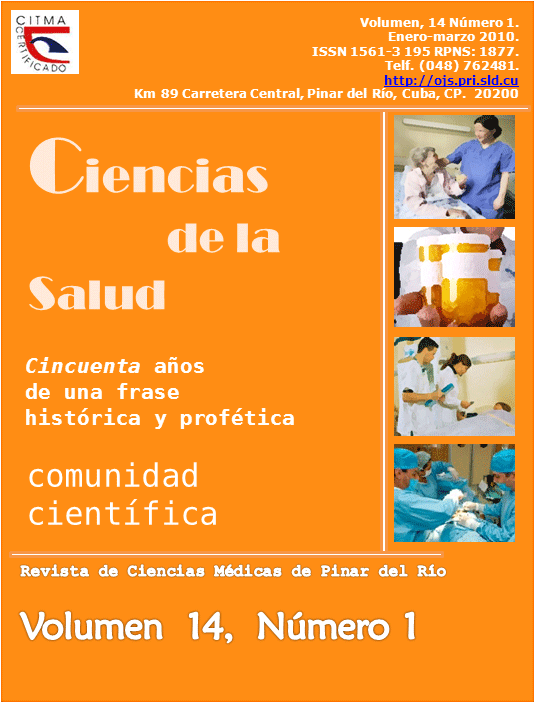Nivel de conocimientos sobre educación para la salud en adolescentes del Politécnico" Pedro Téllez" de Pinar del Río, 2008
Resumen
El Programa Director de Promoción y Educación para la Salud es una expresión de voluntad política y decisión que se encarga de promover, organizar, orientar procesos educativos tendientes a influir en los conocimientos, aptitudes y prácticas relacionadas con la salud del individuo y la comunidad. Si estas acciones educativas se desarrollan en adolescentes la tarea se hace doblemente hermosa y humana. Se realizó un estudio longitudinal y descriptivo de adolescentes que estudian en el Politécnico "Pedro Téllez" del municipio Pinar del Río con la aplicación de técnicas educativas afectivo-participativas como instrumentos de trabajo para evaluar el nivel de conocimientos de Educación para la Salud y factores de riesgos antes y después de una intervención educativa. El universo estuvo formado por 250 alumnos que estudian en el centro escolar y la muestra el 100% del universo en el período de enero 2006 a noviembre 2007, la investigación se realizó en tres etapas, una donde se aplicó la encuesta en la totalidad de la muestra sobre educación para la salud y factores de riesgos, una segunda etapa de intervención que comprendió la ejecución de técnicas afectivas-participativas, una tercera etapa donde se evaluaron los resultados alcanzados. Los datos fueron llevados a figuras y tablas; se aplicó el método estadístico Chi cuadrado. Obteniéndose que el mayor porciento de estudiantes tenían un bajo nivel de conocimientos y al finalizar la intervención educativa se logró que un mayor porciento de los estudiantes poseían elevado nivel de conocimiento. Quedando así demostrado la eficacia del Programa Educativo.
.
Descargas
Citas
1. Oramas Viera A, Santana López S, Vergara Barrenechea A. El bienestar psicológico, un indicador positivo de la salud mental. Revista cubana de Salud y Trabajo [revista en internet], Dic 2006; [citado noviembre 2007], 7(1-2): Disponible en: http://bvs.sld.cu/revistas/rst/vol7_1-2_06/rst06106.html
2. Ministerio de La Salud. Guías Prácticas de Estomatología. La Habana: Editorial Ciencias Médicas; 2002 pp. 494.
3. Organización Panamericana de la Salud. Carta de Ottawa Conferencia Internacional sobre promoción de Salud. Ottawa: OPS 17.21 nov;1986.
4. Piñón Vega José, Torres Hernández Mercedes. Impacto de la promoción y la educación para la salud en los logros de la salud pública cubana. Rev Cubana Med Gen Integr [revista en la Internet]. 2001 Feb [citado 2010 Abr 12] ; 17(1): 91-99. Disponible en: http://scielo.sld.cu/scielo.php?script=sci_arttext&pid=S0864-21252001000100013&lng=es
5. Alemán Sánchez Pedro Carlos, González Valdés Damaris, Delgado Díaz Yaíma, Acosta Acosta Estela. La familia y su papel en los problemas de promoción y prevención de salud bucal. Rev Cubana Estomatol [revista en la Internet]. 2007 Mar [citado Jul 2009]; 44(1): Disponible en: http://scielo.sld.cu/scielo.php?script=sci_arttext&pid=S0034-75072007000100008&lng=es
6. Ministerio de Salud Publica.Programa Nacional de Atención Estomatológica Integral a la población. Cuba . La Habana: MINSAP; 2002. P.3.
7. Cárdenas Sotelo O. Sala Adam M.R, Sosa Adam, Sosa Rosales M. Programa de Promoción y Educación para La Salud Bucal en Adolescentes. La Habana: Editorial Academia; 2002.
8. Dotres C, Córdobas L. Aliño M. Programa Nacional de Atención Integral a la Salud de Adolescentes. La Habana: MINSAP; 2004.
9. Tan Suárez Nerys, Montes de Oca Carmen Alonso, Martínez Padilla Silvia. Promoción de Salud: Un camino para la Estomatología del futuro. Rev Hum Med [revista en la Internet]. 2005 Abr [citado citado Jul 2009] ; 5(1): Disponible en: http://scielo.sld.cu/scielo.php?script=sci_arttext&pid=S1727-81202005000100009&lng=es
10. Garbero I, Delgado AM, Benito de Cárdenas IL. Salud oral en embarazadas: conocimientos y actitudes. Acta odontol. Venez [revista en internet]. 2005 [citado Jul 2009] ;43 (2): Disponible en: http://www.scielo.org.ve/scielo.php?script=sci_arttext&pid=S0001-63652005000200006&lng=es
11. Zacca González Grisel, Sosa Rosales . Maritza, Mojáiber de la Peña Armando. Situación de salud bucal de la población cubana: Estudio comparativo según provincias, 1998. Rev Cubana Estomatol [revista en la Internet]. 2001 Ago [citado Jul 2009] ; 38(2): 90-110. Disponible en: http://scielo.sld.cu/scielo.php?script=sci_arttext&pid=S0034-75072001000200003&lng=es
12. Manau Carolina, Zabalegui Ión, Noguerol Blas, Llodra Juan C., Rebelo Helena, Echevarría José J. et al . Control de placa e higiene bucodental: Resumen de los resultados del 1er Workshop Ibérico. RCOE [revista en la Internet]. 2004 Abr [citado noviembre 2005]; 9(2): 215-223. Disponible en: http://scielo.isciii.es/scielo.php?script=sci_arttext&pid=S1138-123X2004000200006&lng=es
13. Nuñoz Santiago Ch. Salud en adolescentes. Laboratorios Silesia S.A. 2004; Chile- España. Pp. 225.
14. García-Roco Pérez Oscar N., Arredondo López Miguel, Castillo Betancourt Esther María. Factores contribuyentes al diagnóstico tardío del carcinoma bucofaríngeo. Rev Cubana Estomatol [revista en la Internet]. 2006 Mar [citado julio 2008]; 43(1): Disponible en: http://scielo.sld.cu/scielo.php?script=sci_arttext&pid=S0034-75072006000100001&lng=es.
15. Vaculik, Patricia Alejandra. Estudio del estado de salud buco-dental en adolescentes de la ciudad de corrientes. Argentina. Revista facultad de Odontología de la Universidad nacional del Nordeste[revista en internet]. 2007,[citado Jul 2009 ]: Disponible en: http://odn.unne.edu.ar/2007/19.pdf
Publicado
Cómo citar
Número
Sección
Licencia
Aquellos autores/as que tengan publicaciones con esta revista, aceptan los términos siguientes:- Los autores/as conservarán sus derechos de autor y garantizarán a la revista el derecho de primera publicación de su obra, el cuál estará simultáneamente sujeto a la Licencia de reconocimiento de Creative Commons que permite a terceros compartir la obra siempre que se indique su autor y su primera publicación esta revista.
- Los autores/as podrán adoptar otros acuerdos de licencia no exclusiva de distribución de la versión de la obra publicada (p. ej.: depositarla en un archivo telemático institucional o publicarla en un volumen monográfico) siempre que se indique la publicación inicial en esta revista.
- Se permite y recomienda a los autores/as difundir su obra a través de Internet (p. ej.: en archivos telemáticos institucionales o en su página web) antes y durante el proceso de envío, lo cual puede producir intercambios interesantes y aumentar las citas de la obra publicada. (Véase El efecto del acceso abierto).



